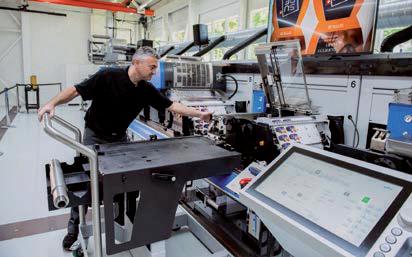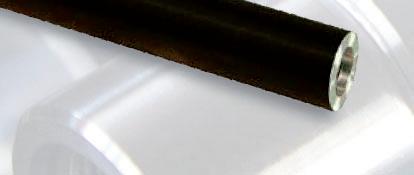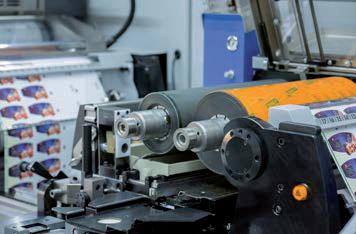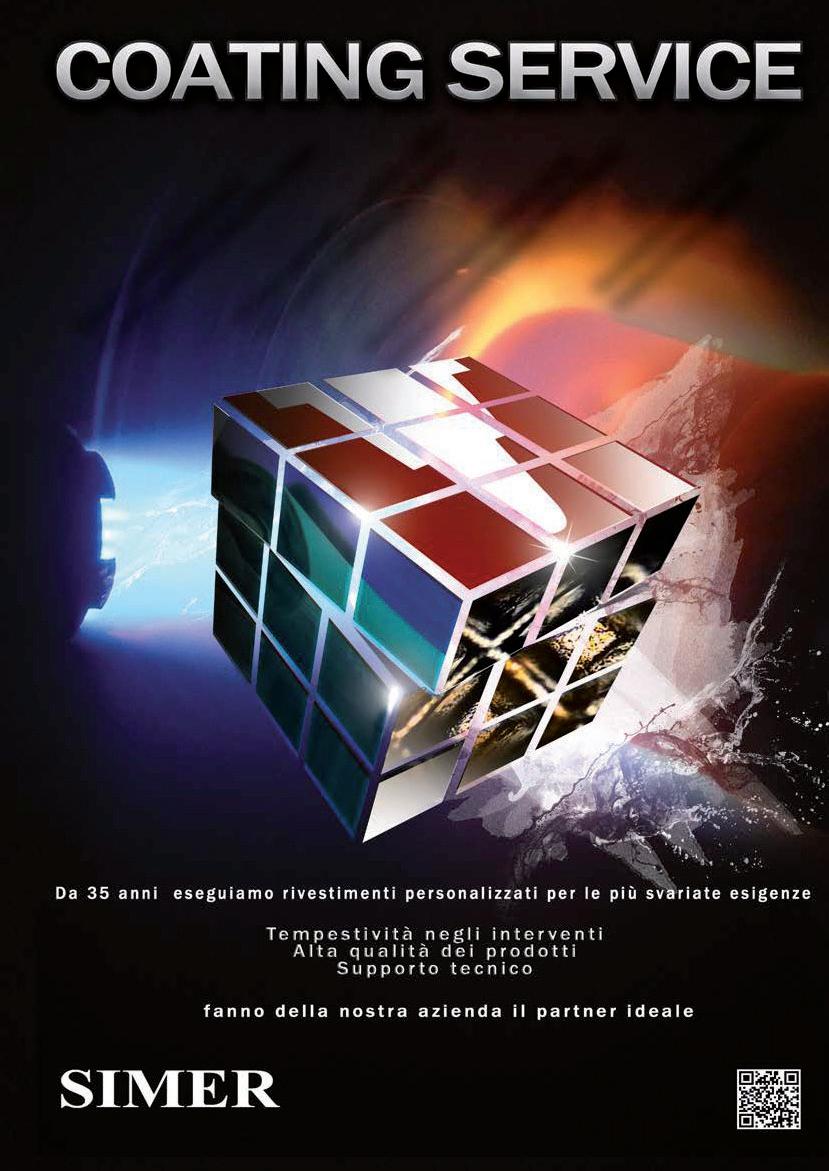
16 minute read
To a stable process (flow) in day-to-day business with process management
mento per i seguenti esempi. Come attrezzatura di base hanno unità di stampa UV offset o UV flexo che possono essere integrate da configurazioni aggiuntive con tutti gli altri processi di stampa convenzionali. Le opzioni per l’espansione possono includere la stampa serigrafica rotativa, la stampa rotocalco a solvente, la goffratura, la metallizzazione a caldo e a freddo e la laminazione.
Le procedure esaminate dalla gestione del processo per controllare i fattori esterni includono: • Tempi di cambio processo • Tempi di preparazione per i cambi di lavoro • Riproducibilità degli ordini • Trasporto del supporto di stampa • Percorsi del materiale in bobina • Diversità del supporto da stampare • Gestione di supporti multi-bobina • Sostituzioni al volo • Soluzioni ibride digitali
Advertisement
INGRESSO NELL’ANALISI DI PROCESSO
Se un’azienda non ha alcuna esperienza nella gestione del processo, un buon modo per iniziare è un progetto pilota, in cui i processi con i tempi di approntamento siano in primo piano; ad esempio, l’analisi delle modifiche agli ordini programmate o dell’ultimo minuto. Poiché il loro numero varia da stampatore a stampatore, la gestione del processo determina quanto frequentemente si verificano i fattori di disturbo e quanto questi siano influenti. In seguito, identifica le modalità con cui i fattori di disturbo possono essere eliminati. Alcuni esempi:
Influenza dei tempi di cambio di processo Le analisi rivelano che un’azienda di stampa di etichette gestisce mediamente per ogni turno quattro cambi di lavoro in cui è necessario un cambiamento del processo di stampa. Il tempo predeterminato di approntamento per la sostituzione di un’unità di stampa è di 30 minuti. In termini concreti, ciò significa che ogni modifica di processo non pianificata ritarda di conseguenza i lavori successivi e in alcuni casi i tempi di consegna devono essere riprogrammati. Se la gestione del processo confrontasse i tempi di cambio del processo in sistemi di stampa equivalenti, scoprirebbe che un sistema di stampa con un percorso ottimizzato della bobina richiede solo 5 minuti per un cambio di processo invece di 30 minuti. Con una media di quattro cambi di processo per turno, questo porterebbe a un risparmio di tempo di 100
ENGLISH Version To a stable process (flow) in day-to-day business with process management
FLEXIBLE PRESS SYSTEMS OFFER THE MOST COST-EFFECTIVE PRODUCTION METHOD WHEN TOTAL COST OF PRINT IS CONSIDERED
In the daily routine business of label printing, unforeseen circumstances frequently disrupt the planned process steps. Often deadline variations or short-term changes mess-up the order sequence or delay the process. A perfectly designed process should be able to adapt quickly to new demands and the prerequisites for such flexibility are created in process management. One of the central tasks in process management is to analyse the causes of disruptive factors and to find solutions that keep the effects on the planned work procedures to a minimum. Thus the aim is to avoid or minimise time loss or additional effort. As well as analysing short-term disruptive factors, process management also pursues medium- to longer-term goals. This involves examining market trends and their impact on the product portfolio. To ensure that equipment can be used universally even when market trends change, great importance is attached to high flexibility of press systems in terms of their configurability and retrofitting. This flexibility, as we will see, spawns useful advantages for day-to-day business.
PROCESS ANALYSIS REVEALS DIFFERENCES IN EFFICIENCY Today’s narrow web presses offer great La sostituzione delle unità di stampa può essere eseguita in pochi minuti. (Fonte: Gallus Ferd. Rüesch AG) / The exchange of printing units can be carried out within a few minutes. (Source: Gallus Ferd. Rüesch AG)
operational convenience due to their modular design and high degree of automation. However, a more detailed analysis of the time required for individual workflow steps reveals significant differences in the set-up and changeover times of the various press systems on offer. In routine business, this leads to significant differences in efficiency. These become particularly noticeable when external




















minuti o consentirebbe il 20% in più di tempo di produzione per ogni turno. La differenza deriva dal fatto che con il secondo sistema di stampa, la bobina non deve essere tagliata durante il cambio di processo. Qualora le modifiche al processo con breve preavviso diventassero necessarie nelle attività di routine quotidiane, non avrebbero praticamente alcun effetto sulla programmazione e sulla disponibilità della macchina con questo sistema di stampa. Il sistema diventa quindi molto meno suscettibile alle influenze esterne e la produzione è più conveniente.
Influenza dei cambi di inchiostro o verniciatura Le modifiche all’inchiostro o alle vernici sono tra le attività più comuni quando si passa a un nuovo lavoro e si verificano relativamente spesso nelle attività quotidiane. Ad esempio, quando si passa da una vernice opaca a una lucida, tutte le parti dell’unità di inchiostrazione come la camera racla, la pompa dell’inchiostro con i tubi e il serbatoio dell’inchiostro, devono essere sostituite o pulite. In alternativa, e in modo relativamente semplice, il tempo di cambio sulla macchina potrebbe essere abbreviato sostituendo l’intera unità di stampa. Il prerequisito è che la struttura della macchina da stampa lo consenta senza la necessità di tagliare la bobina. Per fare ciò, viene preparata un’unità di stampa con la nuova vernice all’esterno della macchina attualmente in funzione, e viene sostituita al cambio del lavoro. Questo richiede circa 5 minuti, rispetto ai circa 15 minuti necessari per la pulizia dell’unità di inchiostrazione o verniciatura durante il cambio. Con la possibilità di cambiare le unità di stampa senza tagliare la bobina, i cambi di inchiostro/vernice non programmati non hanno quasi alcun impatto sulla pianificazione delle attività quotidiane. Inoltre, c’è la possibilità di realizzare modifiche di stampa al volo (“Flying Inprint”). Come nell’esempio precedente, questo metodo di produzione si basa sulla preparazione di una nuova unità di stampa, mentre la macchina è in funzione, e quindi sulla sostituzione dell’intera unità di stampa in macchina. Ciò significa che il testo o l’inchiostro possono essere modificati anche con breve preavviso evitando fermi macchina, senza tempi di cambio formato e con i più bassi costi di produzione.
Automazione durante il cambio di lavoro La gestione del processo può anche concentrarsi su obiettivi qualitativi, ad esempio la riproducibilità e quindi l’affidabilità nella produzione delle ristampe. In molte aziende di stampa, circa due terzi dell’attività consiste in ristampe o lavori con piccole modifiche. Tale condizione è ideale per i cambi di lavoro automatizzati. I dati completi di preparazione per la macchina vengono
influencing factors come into play and not everything goes according to plan. Which is why larger label and packaging printers carefully examine the process times of individual workflow steps of the press systems they use and apply their findings to optimise the process sequences.
PRACTICAL REFERENCE VALUES Performance data for current press systems in practical operation serve as reference values for the following examples. As basic equipment they have either UV offset or UV flexo printing units which may be supplemented by additional configurations with all other common printing processes. The options for expansion include rotary screen printing, partial solvent gravure printing, hot-foil embossing and cold-foil application, coating and lamination.
Procedures that process management examines to control external factors, among others: • Process changeover times • Set-up times for job changes • Reproducibility of orders • Web transport • Web paths • Substrate diversity • Multi-Web • Flying Inprint • Digital Hybrid Solutions
ENTRY INTO THE PROCESS ANALYSIS If a company does not have any experience in process management, a pilot project is a good way to get started, in which processes with set-up times are in the foreground; for example the analysis of planned or last-minute order changes. Since their number varies from print shop to print shop, process management determines how often disruptive factors occur and how influential they are. It then identifies ways in which the disruptive factors can be eliminated. Here are a few examples: L’unità di stampa flessografica predisposta all'esterno della macchina da stampa è posizionata all'interno della macchina per operazione di verniciatura. (Fonte: Gallus Ferd. Rüesch AG) / The flexographic printing unit prepared outside the press is positioned inside the press for coating application. (Source: Gallus Ferd. Rüesch AG)

Influence of process change times In the analysis, the structure of a label printing company shows an average of four job changes per shift where a process adjustment is necessary. The pre-determined changeover time for the exchange of a printing unit is 30 minutes. In concrete terms, this means that each unscheduled process change delays subsequent jobs accordingly and deadlines



La gestione del processo registra la frequenza con cui si verificano deviazioni nel registro durante il cambio automatico. (Fonte: Gallus Ferd. Rüesch AG) / Process management records how often deviations occur in the register during automatic changeover. (Source: Gallus Ferd. Rüesch AG)
recuperati da un file di lavoro e tutti i parametri necessari per l’avanzamento della bobina, il registro longitudinale e trasversale, i parametri di stampa e di fustellatura vengono impostati automaticamente. I sistemi di stampa mostrano anche differenze significative quando si tratta di cambi automatici di lavoro, che si riflettono nella riproducibilità della qualità di stampa. La gestione del processo registra la frequenza con cui si verificano deviazioni durante i cambi automatici e quanto tempo è necessario per il riadattamento. La massima riproducibilità si ottiene con sistemi di stampa in cui i servomotori ad azionamento diretto controllano la movimentazione dei rulli. Le unità di stampa che utilizzano ruote dentate o cinghie non hanno questa precisione.
Multi-bobina e ampliamento del portafoglio prodotti Quando si cambiano i supporti, le moderne macchine da stampa accedono a un database di materiali e regolano la tensione della bobina lungo l’intero percorso in macchina, a seconda del prodotto utilizzato. La qualità del percorso del materiale rientra nell’interesse della gestione del processo, sia per la variabilità che per la diversità dei materiali. Questa determina la flessibilità con cui un sistema di stampa può trattare diversi supporti. Il controllo della tensione del nastro è particolarmente importante per le nuove applicazioni di tendenza in multi-bobina. Due bobine vengono stampate in linea e quindi giuntate assieme. I dati dei due materiali devono essere definibili indipendentemente l’una dall’altra in modo che le bobine possano essere accoppiate
have to be rescheduled in some cases. If process management compares the process change times of equivalent press systems, it will show that a machine system with optimised web run requires only 5 minutes for a process change instead of 30 minutes. With an average of four process changes per shift, this leads to a time saving of 100 minutes, or allows 20 % more production time per shift. The difference results from the fact that with the second machine system, the web does not have to be separated during the process change. If process changes become necessary at short notice in daily routine business, they have virtually no effect on scheduling and machine availability with this press system. The system is therefore much less susceptible to external influences and production is more cost-effective.
Influence of ink or coatings changes Ink and coatings changes are among the routine activities when changing over to a new job and occur relatively frequently in daily business. When changing from matt to gloss coating, for example, all parts of the inking unit such as the ink chamber, ink pump with hoses and ink reservoir must be replaced or cleaned. Alternatively, and relatively simply, the changeover time of the press could be shortened by changing the entire printing unit. The prerequisite is that the press system allows this without the need to break the web. To do this, a printing unit is prepared with the new coating outside the running press and swapped in at the end of the job. This takes around 5 minutes, compared to around 15 minutes for cleaning the inking/ coating unit during changeover. With the possibility of changing printing units without breaking the web, unscheduled ink/ coating changes have hardly any impact on the scheduling of daily business. In addition, there is the possibility of producing “Flying Inprint”. As in the example above, this production method is based on preparing a new printing unit while the press is running and then switching the printing units. This means that text or ink can be changed even at short notice avoiding press stoppages, without any changeover time, and with the lowest production costs.
Automation during job changeover Process management can also focus on qualitative goals, for example the reproducibility and thus the production reliability of repeat jobs. In many printing plants, around two-thirds of their work consists of jobs with minor changes or repeats. Such a structure is ideal for automated job changeover. The complete make-ready data for the press is retrieved from a job file and all the necessary parameters such as web leads, longitudinal and cross register, print parameters and the press’s die-cutting tool are set automatically. The machine systems also show significant differences in automatic job changes, which are reflected in the reproducibility of the print quality. Process management records how often deviations occur during automatic changeovers and how much time is needed for readjustment. Maximum reproducibility is achieved with press systems in which direct drive servo motors control the drive rollers. Printing units in which gear wheels or belts are used do not have this precision.
MultiWeb and product portfolio expansion When changing substrates, modern presses access a substrate database and adjust the web tension across the entire web path, dependent on the material. The quality of web transport falls within the interest of process management, both for material changes and for material diversity. It determines how flexibly a press system can process different substrates. Web tension control is particularly important for new trend multi-web applications. Two webs are printed inline and then spliced together. The substrate data of the two webs must be definable independently of each other so that the webs fit each other in-register. The multi-web label must not




a registro. L’etichetta stampata in multi-bobina non deve arricciarsi o allentarsi a causa di diversi fattori di allungamento prima o durante l’applicazione sul prodotto finale. Per applicazioni multi-bobina o di sicurezza, è spesso richiesta un’opzione di perforazione nell’area di stampa. A tale scopo deve essere possibile installare cilindri di punzonatura e contro-punzonatura in posizione con il minimo sforzo meccanico. Questo è l’unico modo per garantire una produzione conveniente.
Tendenze di mercato Inchiostro bianco ad alta coprenza, effetti speciali di verniciatura o diverse opzioni di finitura della stampa sono un requisito crescente in tutti i segmenti di mercato. Per poter seguire le tendenze, i sistemi di stampa sono soggetti alla revisione nella gestione del processo riguardo la loro espandibilità e flessibilità. Le unità di stampa serigrafica, che stampano strati di inchiostro e vernici di grammatura molto elevata, e anche i sistemi di applicazione di lamine a caldo o a freddo devono consentire di essere integrati in una macchina da stampa con il minimo sforzo e percorsi di bobina brevi. Anche
Con il cambio di stampa al volo “Flying Inprint”, l'inchiostro o il testo possono essere modificati senza arrestare la macchina. (Fonte: Gallus Ferd. Rüesch AG) / With Flying Inprint, ink or text can be changed without stopping the machine. (Source: Gallus Ferd. Rüesch AG) qui ci sono differenze significative nella configurabilità dei sistemi, che determinano la quantità di scarto in fase di avviamento.
Alto grado di automazione e massima flessibilità Gli esempi sopra elencati mostrano quanto spesso i fattori di disturbo influenzano le attività quotidiane e quanto sia grande il loro impatto sui processi pianificati. Nella ricerca di soluzioni per la gestione del processo, i vantaggi dei sistemi di stampa che offrono la massima flessibilità possibile sono evidenti. Con le loro attrezzature e il grado di automazione, offrono i prerequisiti necessari per lavorare in modo efficiente anche in presenza di fattori di disturbo nell’attività quotidiana. Eventuali sequenze “sfavorevoli” di ordini o tempi di avviamento più lunghi influiscono minimamente sull’efficienza dei processi produttivi. Pertanto, i sistemi di stampa flessibili offrono l’opzione economicamente più efficiente per le attività quotidiane di routine, nonostante i costi associati di acquisizione più elevati. La gestione del processo lo dimostra analizzando i costi delle singole fasi di lavoro e confrontando i costi totali dei sistemi di stampa.

curl or loosen due to different elongation factors before or during application to the end product. For multi-web or security applications, a punching option is often required in the print area. For this purpose, it must be possible to install punching and counter-punching cylinders in position with minimal mechanical effort. This is the only way to ensure cost-effective production.
Market trends Highly opaque white, special varnish effects or print finishing options are an increasing requirement in all consumer markets. In order to be able to follow the trends, the press systems are being reviewed in process management for their expandability and flexibility. Screen printing units, which print very high film weights of ink and coatings, and also hot or cold foil application systems must be able to be integrated into a press with minimum effort and short web paths. Here, too, there are significant differences in the configurability of the systems, which determine the amount of waste during make-ready.
High degree of automation and maximum flexibility The examples listed above show how often disruptive factors influence day-to-day business and how great their impact is on planned processes. In the search for solutions in process management, the advantages of press systems that have the greatest possible flexibility emerge. With their equipment and degree of automation, they offer the necessary prerequisites to work efficiently even under disruptive factors in day-to-day business. Even an “unfavourable” order sequence or increased set-up times barely affect the efficiency of the production processes. Thus, flexible press systems offer the most economically efficient option for routine daily business, even with their associated higher acquisition costs. Process management proves this when comparing the costs of individual work steps and in a total cost comparison of press systems.










